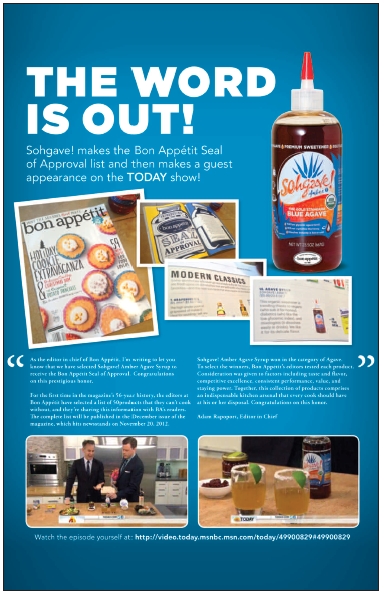In seminars around the country, I ask independent natural products retailers if they believe their store is a distinct brand. Usually only a few raise their hands. But even if you don’t think of yourself or your store as a brand, your customers do…and I can prove it to you.
“Remember that Little Green Bottle?”
When I ask retailers how many have had customers say something like, “Do you remember that little green bottle I bought last month?” everyone in the audience nods their head and laughs. It appears to be universal that customers don’t remember the brand of product they bought from you, but they do remember you and your store. Creating a memorable shopping experience that customers wish to repeat is the goal of brand marketers. So, customers returning to your store when they’ve forgotten which products they bought from you demonstrates that you have made a memorable impression in their minds: your store is a distinct brand, whether you realize it or not.
What Is a Brand?
 A brand is a promise of value, and that value can be high, low or just “good enough.” As long as your customer consistently receives the value he or she expects, you are successfully delivering on your brand promise, and creating a powerful psychological shortcut to future buying decisions.
A brand is a promise of value, and that value can be high, low or just “good enough.” As long as your customer consistently receives the value he or she expects, you are successfully delivering on your brand promise, and creating a powerful psychological shortcut to future buying decisions.
Just think about the word-of-mouth referrals you get from satisfied customers. “Joe says you really know what you are talking about.” “Mary told me the products you recommended really helped her feel better.” These comments tell you that in the minds of your customers—the only place it really matters—you are the “knowledgeable” brand, and the “feel better” brand.
In today’s world of skeptical and hyper-demanding consumers, being the “feel better, know-it-all” brand has significant value, wouldn’t you say? If not, I believe you may be missing an opportunity to create momentum in your business to propel your sales higher for many years.
What Can You Do About It?
If you are continuing to read this, I assume you are willing to consider your store is indeed a brand unto itself. But how can you proactively promote your brand? Natural products retailers have succeeded for decades on good word-of-mouth, but what control do you have over it? What makes you likeable and makes people want to do more business with you?
Fortunately, other thinkers have devoted years to answering this question scientifically. Robert Cialdini, Ph.D., professor emeritus of psychology and marketing at Arizona State University, has studied the art of influence for many years. Through his real-world research, Cialdini has identified six “principles of persuasion”; motivators that help move people in your direction. Let’s see how we can apply these influence factors to building your brand.
Using Science to Build Your Brand
Here are the six factors proven to influence people’s behavior.
1. Consensus, or social proof, means that others—third parties unaffiliated with you or your business—freely endorse you or your store. Consensus most often operates in our industry as word-of-mouth. Someone likes your store, the way you treated them and the results they got. So, they spontaneously tell their friends, neighbors, family and co-workers. For consensus or social proof to work, it must be unsolicited. In other words, you can’t pay for an endorsement and generate the same powerful spontaneous human response.
 Of course, marketers pay for endorsements all the time, and they work, but not with the same effect as an authentic, unsolicited endorsement. Are you good at working with local MDs? Perhaps you’ve got a few open-minded doctors in your community who trust your knowledge. Some retailers I know have local doctors who write natural “prescriptions,” sending their patients into the retailer’s store with a list of nutrients recommended by the doctor. This is another great example of third-party consensus: the doctor’s recommendation and implied trust. Perhaps your store was voted “Best Health Food Store in East Cupcake.” This is yet another form of consensus and social proof. What other examples of consensus can you think of that are operating for you and your store?
Of course, marketers pay for endorsements all the time, and they work, but not with the same effect as an authentic, unsolicited endorsement. Are you good at working with local MDs? Perhaps you’ve got a few open-minded doctors in your community who trust your knowledge. Some retailers I know have local doctors who write natural “prescriptions,” sending their patients into the retailer’s store with a list of nutrients recommended by the doctor. This is another great example of third-party consensus: the doctor’s recommendation and implied trust. Perhaps your store was voted “Best Health Food Store in East Cupcake.” This is yet another form of consensus and social proof. What other examples of consensus can you think of that are operating for you and your store?
2. Authority. People value perceived expertise. Are you a nutritional expert? Has your store been in business for a long time, longer than any of your competitors? The longer your time in the marketplace, the more likely shoppers are to believe you have authority. Do you have high ingredient standards? Being picky about what you will and won’t carry is another sign of your expertise; you are a trusted gatekeeper for quality, an editor selecting only the best products for your customers. Are you a certified nutritionist? An RN? Letters after your name for degrees you’ve earned in nutrition or medicine tell customers you are an unbiased, impartial expert who will give them authoritative advice. Are you a member of any industry associations? Many of your achievements can represent authority in the minds of your customers.
3. Reciprocity. The human desire to repay debts runs deep. This is the “You scratch my back, I’ll scratch yours” phenomenon. When you sponsor your local Little League team, or adopt a school classroom and donate study materials, those in your community who benefit from your participation naturally feel indebted to you and a need to reciprocate; to pay you back for your efforts and generosity. Even small, simple gestures, such as giving away product samples, introducing customers to new products, and making a concession—as in extending the date of a sale promotion—generate the desire on the part of your customer to pay you back.
4. Liking. It will surprise no one that the more people like you, the more business they’ll do with you. But think about the service level you provide in your store. How much of the time is your staff being truly likeable? Are you subject to grumpy nutritionists or self-absorbed workers who give the impression they’d just as soon not be disturbed by customers?
Likeability is so powerful that probably half of all decisions to do business—or to not do business—are driven by a knee-jerk reaction, “I don’t like that guy.” What builds liking? Listening rather than talking. Matching body language—people respond to those they perceive as similar to them. Nodding in agreement, demonstrating empathy and understanding with a well-timed “Mm-hmm.” Smiling. Ever hear of mirror neurons?
There’s truth to the song lyrics, “When you’re smiling, the whole world smiles with you.” Try an experiment. Make a happy face, and then an annoyed face and watch the reactions of those around you. Mirror neurons lead us to mimic the expressions we see in others.
Also, smiling is attractive, and people respond favorably to physical attractiveness. People also respond well to those they perceive as cooperative.
5. Consistency. This may be one of the most subtle elements of influence. Public commitments—expressions of belief or attitude—even minor ones, prompt consistent future action. A famous study demonstrates the consistency principle. We’ll call it the “bumper sticker” study. In the first phase, researchers knocked on the door of a house and asked the resident, “Do you think X charity is a worthy cause?” Nine out of 10 answered yes. The next week, researchers went back to the same houses and asked the residents to donate to the charity. Nine out of 10 said no.
In the second phase of the study, researchers knocked on the door of a house and asked if the resident thought charity X was a worthy cause, with the same result: nine in 10 said yes. The next week, the researcher went back to the same houses and asked the residents to place a bumper sticker for the charity on their car. Most complied.
On the third week, researchers went back to the bumper sticker houses and asked for a donation to the charity. Nine in 10 said yes. What was the difference? The public commitment, in the form of a bumper sticker stating the driver’s belief about the charity, led the person to align their behavior with their—publicly stated—beliefs.
So, how can you apply the consistency principle to your business? We all know by now that when asked, most women and men on the street say they believe natural and organic foods are better for you—their publicly stated belief. But most aren’t following through by buying natural products. If they were, your store would be five times its present size! When you get someone to taste a natural product for the first time, and it tastes good, people who have said they believe natural is better—but secretly believed natural foods taste bad—are now confronted with the fact that they’ve been wrong about bad taste, and must now align their behavior with their public statements, and buy the product. They will be even more likely to buy the product if it is close in price to conventional products they now buy. Consistency; subtle but very powerful.
6. Scarcity. Scarcity may be the most fun of all the elements of influence because it is easy to create. You may have noticed the durations of sales at various retailers or online are shortening. No longer do specials last an entire month. Rather, two to three weeks, two or three days, or even “one day only.” “While supplies last” is a familiar trick to generate urgency. The scarcity effect increases when people believe they are competing with others for limited offers. When you’ve got a special formula, edition, hard-to-locate or seasonal item, or limited seating for an expert lecture, you’ve got an easy way to create scarcity.
Putting Influence to Work for Your Brand
I’ve laid out examples for each of the six elements of influence that you can apply to your store: authority, consensus, reciprocity, liking, consistency and scarcity. As a project, challenge your team to identify an example of each principle they’ve seen at work in your store. By putting together a comprehensive list of these factors, you can begin to utilize these influencers in your advertising and marketing, in your in-store merchandising, on shelf talkers, point-of-sale signage, at your checkout stand, on your Web site, in press releases, on your blogs and social media platforms. Once you develop your awareness of what moves people to action, you’ll get better at creating the circumstances and situations in and around your store that change people’s behavior and draw them closer to your business—and deeper into your singular brand.
I’d love to hear of your challenges and successes. Good luck! WF
Jay Jacobowitz is president and founder of Retail Insights®, a professional consulting service for natural products retailers established in 1998, and creator of Natural Insights for Well Being®, a comprehensive marketing service designed especially for independent natural products retailers. With 36 years of wholesale and retail industry experience, Jay has assisted in developing over 1,000 successful natural products retail stores in the U.S. and abroad. Jay is a popular author, educator, and speaker, and is the merchandising editor of WholeFoods Magazine, for which he writes Merchandising Insights and Tip of the Month. Jay also serves the Natural Products Association in several capacities. He can be reached at (800)328-0855 or via e-mail at jay@retailinsights.com.
Published in WholeFoods Magazine, March 2013










